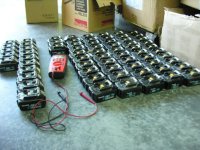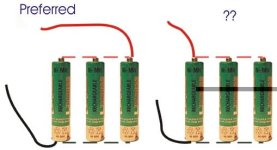LOL
PJD is right, I AM an arrogant fool who is clueless...
Byt the way, I have created a single cell BMS for TS cells that is working out great.
It sits on top of the cells and does not add to the height.
It can remove up to 10 amps but I limit it to 2 amps due to heat concerns but if your application is not sealed in tight it can do 10 amps.
It provides low and high cell protection (cuts off charger or bike) and turns charger back on when voltage is brought back into tolerance from the voltage clamp device.
I have two units testing on two cells, I have a proto unit for my bike underway so road testing will commence in a few weeks, I will be looking for things I know nothing about like interence to the circuitry from motor noise etc...
And I will also be evaluating how the circuits I designed and built actually function when placed in daily use, I expect the worst, I only leanred electronics in about 10 days from self taught methods, but so far, it has met and exceeded all my design goals.
It is infinitely expandable, you buy only for the cells you need, a single wire plugs them all in together in a chain which goes to a master control unit to interface to charger and controller for low and high voltage shut down.
It is truly infinite because even if you reach the limit for how many cells the MCU can monitor (I dont know how many that is yet, surely more than 50 but some weird thing called impedance will limit it

but in that case, you just add another MCU and ties the MCU's together.
The entire unit is a PCB just slightly smaller than the top of the cells, and has a bushing soldered in the temrinal areas so you can torque the temrinals down on the board without risk of breaking it, of course, the board is powered by bolting it to the cell.
Necessity is the mother of invention, and sometimes it takes and idiot to invent the solution for the need, I just may be that idiot

PS PJD, you really should remove that unsubstantiated posting on this system where you claim Elite Power Solutions may be the source for counterfiet TS cells, since they are the international distributor for TS cells, and since you have NOTHING to back up your absurd assertion, it is really not a warranted attack. I know you have posted I am a thief, and Nova Scooters bikes are all crap, don't care about that, but I don't get this constant intent you have to attack baselessy the vendors of this (hobby?) (interest?) while also railing there aren't anough non-chinese connections for the industry.
I have also brought your posting up to EPS, who also posts on this system. I believe, by the way, that your entire basis on the subject of countefiet cells came from MY testing and reports of the counterfiet cells in my possession, and as such, have no idea where you came up with dragging EPS into this as I have NEVER stated WHERE the TS countefeit cells were source from, not publicly, at his been revealed to TS N and TS S and others in the industry in China, Taiwan, New Zealand, Australia, Germany, California and other countries that are involved in our network, but none of those communications are ever posted on the net or revealed to non-members, and I know you are not one, so not sure where you got the info the EPS is the source of the bad cells, assuming you even have a source for the posting to begin with.
But what do I know, I am and idiot and probably a shyster






